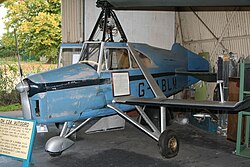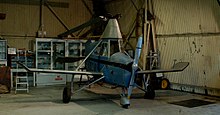Cierva C. 24
| Cierva C. 24 | |
|---|---|
 C.24 in the de Havilland Aircraft Museum |
|
| Type: | Gyroplane , experimental aircraft |
| Design country: | |
| Manufacturer: | |
| First flight: |
September 1931 |
| Number of pieces: |
1 |
The Cierva C.24 (also de Havilland C.24 ) was a cabin autogyro in 1931 in one copy in the UK at the de Havilland Aircraft Company designed and built. Only the rotor system came from the Cierva Autogiro Company . The design was not included in the series of Havilland designations by the factory, so the designation DH24, which is occasionally used, is not applicable. Among them, de Havilland led a not pursued development of the DH18 .
history
The aim of developing a gyroplane for de Havilland was to carry out comparative studies with the fixed-wing aircraft DH.80 Puss Moth, which is in series production . The final design was carried out by Charles Wilkins, who started work in 1928 as the right-hand man of de Havilland RE Bishop's chief designer. The construction, which was completed in late August 1931, was carried out by de Havilland students in Stag Lane . Characteristic features of the C.24 are the towering cladding of the rotor pylon, the nose-wheel landing gear, which was previously unusual for gyroplanes, and a narrow front view due to the tandem seat arrangement. The shape of the trunk was reminiscent of a puss moth compressed in the longitudinal axis.
Like the Puss Moth, the C.24 was powered by a 120 hp de Havilland Gipsy III engine. The short wings had ends angled upwards and were braced against the rotor pylon. The machine had a conventional tail unit, with the fuselage ending in a sharp edge having a rudder at the end. An elevator fin was dispensed with, as it was assumed that the slim fuselage stern would provide sufficient directional stability.
The first flight took place in September 1931 at the de Havilland factory airfield in Stag Lane and was carried out by Juan de la Cierva himself , as is usual for all first flights of Cierva gyrocopes . The inadequate directional stability was already evident on the first flights, so that the very short fuselage had to be lengthened and the control surfaces enlarged. The latter was done by adding a rudder fin and attaching end caps to the elevator. Cierva presented the modified machine to the press on November 19, 1931, together with the C.19 Mk.IV, at the opening of his gyroplane service station in Hanworth . However, compared to the C.19, the C.24 showed the significantly poorer performance values on this occasion.
The C.24 received its type certification on April 23, 1932. The aircraft registration G-ABLM had already been assigned to it. From May 27 to June 9, 1932, de la Cierva undertook a European sales tour with the machine, covering 2,400 km. Countries visited included Spain, Germany and the Netherlands. When participating in the London-Newcastle Air Race in August 1932, the G-ABLM reached sixth place out of 18 starters with an average speed of 166 km / h, which is relatively high for a gyroplane, but was exceeded by older Moth types. On October 18, 1932, the C.24 was involved in an accident, and it is doubtful whether it ever flew again afterwards.
Series production of the model did not take place because it did not offer any significant advantages compared to the fixed-wing aircraft from the de Havilland program that were already in production. In addition, the factory was already largely busy with the series production of Puss Moth and Tiger Moth .
construction
The structure of the front fuselage part was a steel construction, while the rear part and the tail unit were made of wood. Overall, the fuselage was covered with fabric. The three-blade rotor was designed to be foldable. The sheets had an RAF 34 profile and consisted of a tubular steel spar with a core of pine wood and balsa blocks that formed the profile. Before the start, the rotor was brought to a speed of around 200 min −1 within 50 seconds by an output shaft on the back of the Gipsy III . When the gyroplane began to move forward, the drive shaft was disengaged.
The wings with a span of 5.95 m were a two-spar wooden construction. The over the span ranging ailerons had a metal pipe Holm. The fixed nose wheel landing gear had Bendix wheels with low pressure tires and Bendix brakes. Because of the usual landing technique with a strongly raised nose, the fuselage stern had a glide spur as a protective device. The entry for the two passengers sitting one behind the other was via a door on the right-hand side. Although a double control was planned, the instruments were all in the front cockpit.
The Gipsy III used had been modified by Frank Halford for the temporary rotor drive. Halford had previously retrofitted an ADC motor in the same way for use in the Cierva C.11 .
Whereabouts
In September 1935 de Havilland donated the C.24 to the London Science Museum , where it was exhibited for a while, but was then put into storage. It was only exhibited again in July 1951 during a flight day at RAF Hendon airfield , but the engine was missing. In the 1960s it was transferred to the Aeronautical Technical School of Hawker Siddeley Aviation , where it was to be prepared for static exhibitions again. A replacement engine and a new triplex screen were installed, but the original fabric covering was retained. In February 1974 the C.24 was formally returned to the Science Museum, but actually remained in the Mosquito Aircraft Museum of de Havilland in Salisbury Hall. The present name of the museum is de Havilland Aircraft Museum .
Technical specifications
| Parameter | Data |
|---|---|
| crew | 2 |
| length | 6.10 m (7.22 m with folded rotor) |
| Rotor diameter | 10.37 m |
| Wingspan (fixed wings) | 5.95 m |
| height | 2.72 m |
| Empty mass | 581 kg |
| Max. Takeoff mass | 817 kg |
| Top speed | 184 km / h |
| Cruising speed | 152 to 160 km / h |
| lowest horizontal speed | 40 km / h |
| Takeoff route | 40 m |
| Landing route | 0 under normal conditions |
| Range | 560 km at 155 km / h |
| Engine | 1 × four-cylinder - de Havilland-Gipsy-III - in- line engine with an output of 120 PS (88 kW) |
See also
literature
- Arthur WJG Ord-Hume: Autogiro - Rotary Wings Before the Helicopter , Mushroom Model Pub., 2009, ISBN 978-83-89450-83-8 , p. 91 f., P. 289
- Richard Riding: Cierva C. 24 Autogiro - British pre-war lightplanes No 5 . In: Airplane Monthly April 1989, pp. 246-250
- AJ Jackson: De Havilland Aircraft since 1909 , Putnam, 1962, 3rd edition 1978, ISBN 0-87021-896-4 , p. 526
Web links
Individual evidence
- ↑ Riding, 1989, p. 250

